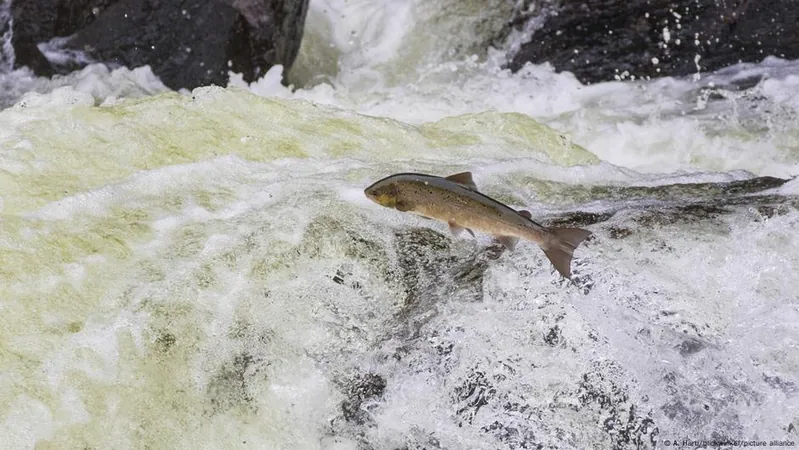
Alarming Discovery: Anti-Anxiety Drug Disrupts Salmon Migration!
2025-04-11
Author: Ken Lee
Psychoactive Pollution: A Threat to Salmon?
A shocking study from Sweden reveals that clobazam, a common anti-anxiety medication found polluting our waterways, is impacting the migration patterns of wild Atlantic Salmon. This research, published in the prestigious journal *Science*, shows that exposure to clobazam makes these fish less cautious, ultimately affecting their critical migration.
The Study's Eye-Opening Findings
Lead researcher Jack Brand from the Swedish University of Agricultural Sciences discovered that salmon exposed to the drug were more likely to successfully migrate to the sea, and they navigated around man-made obstacles, like hydropower dams, at a quicker pace than their drug-free counterparts. While this may seem like a positive outcome, Brand warns that such changes in behavior could unleash unforeseen negative consequences for ecosystems.
Global Drug Pollution: A Silent Crisis
Surveys conducted around the globe have unveiled a disturbing trend: traces of pharmaceutical drugs, including clobazam, have been detected in bodies of water on every continent, even Antarctica! Nearly 1,000 different active pharmaceutical compounds have infiltrated our ecosystems, jeopardizing biodiversity and public health.
How the Research Was Conducted
To study the effects of clobazam on salmon, researchers tracked 279 wild fish equipped with telemetry devices and slow-release clobazam implants as they migrated along the River Dal in Sweden. Their findings were striking; unexposed salmon traversed hydropower dams at a much slower rate than those under the influence of the drug.
Behavioral Changes: A Double-Edged Sword
Further laboratory experiments confirmed that clobazam altered salmon's group dynamics, leading to looser shoals during predator encounters. This disruption could expose the fish to higher predation risk and delay their journey to the sea, potentially affecting their survival and reproductive success in the future.
Future Risks and Unknowns
The long-term implications of pharmaceutical pollution on salmon populations remain unclear. As ecologist Josefin Sundin noted, the study followed the fish only for about ten days, leaving us in the dark regarding their fate in the expansive Baltic Sea or during their return migrations to breed.
Widespread Impact of Pharmaceutical Pollution
This study adds to a growing body of research highlighting the dangers of pharmaceutical pollution. Hundreds of pharmaceutical compounds have been tested, revealing concerning impacts on numerous aquatic species. Pollutants seep into our waterways through sewage treatment failures and livestock runoff, leading to dire effects on fish populations.
Solutions and Hope on the Horizon
Increasing awareness and improving wastewater treatment systems is crucial, but it's not enough alone. Advanced technologies like membrane filtration are promising, yet not widely available. Experts advocate for a revolutionary approach called "green chemistry," which focuses on designing drugs that degrade more quickly and are less harmful to the environment.
Stricter regulations and better disposal practices are also essential to mitigate the pharmaceutical crisis before it begins. Collaborative efforts across science, policy, and industry may hold the key to curbing the risks posed by pharmaceutical pollution.
A Call to Action for Our Ecosystems!
The findings of this study serve as a wake-up call. As we face the repercussions of our actions on wildlife, it’s urgent that we unite to combat pharmaceutical pollution, emphasizing sustainable practices to protect our invaluable ecosystems and the creatures that inhabit them.

 Brasil (PT)
Brasil (PT)
 Canada (EN)
Canada (EN)
 Chile (ES)
Chile (ES)
 Česko (CS)
Česko (CS)
 대한민국 (KO)
대한민국 (KO)
 España (ES)
España (ES)
 France (FR)
France (FR)
 Hong Kong (EN)
Hong Kong (EN)
 Italia (IT)
Italia (IT)
 日本 (JA)
日本 (JA)
 Magyarország (HU)
Magyarország (HU)
 Norge (NO)
Norge (NO)
 Polska (PL)
Polska (PL)
 Schweiz (DE)
Schweiz (DE)
 Singapore (EN)
Singapore (EN)
 Sverige (SV)
Sverige (SV)
 Suomi (FI)
Suomi (FI)
 Türkiye (TR)
Türkiye (TR)
 الإمارات العربية المتحدة (AR)
الإمارات العربية المتحدة (AR)